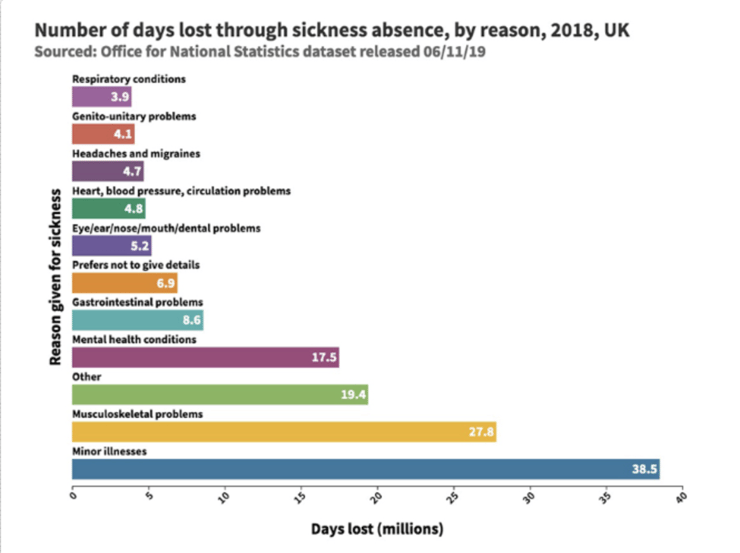3 Ways to Promote Mental Health Awareness in the Workplace

If you’re serious about employee engagement, you need to take a hard, long look at how you handle (or fail to handle) mental health awareness at your company. Check out Ambassify’s Ultimate Guide to Employee Engagement and learn how to grow healthy, motivated, and productive teams by focusing on the essential cornerstones of workplace engagement.

When a professional runner sprains their ankle, no one expects them to shrug it off and pretend that it’s nothing. They’re expected to rest, heal, and get to 100% before they get back out on the track.
For some reason, however, this same courtesy is not always extended to employees struggling with mental health issues.
They are mostly encouraged to shrug off their depression or their anxiety and to show up for work regardless of their mental acuity on that particular day. They’re expected to be engaged, productive, courteous, and approachable. Otherwise, they’re accused of having an “attitude.”
This just shows that organizations have a long way to go when it comes to understanding mental health difficulties or how to support employees who are struggling with them (and that’s one out of every seven employees, according to the latest studies).
How does employee mental health affect the bottom line?

Mental health is one of those issues where doing the right thing for the employees aligns perfectly with what’s good for the bottom line. Companies have a strong financial incentive to address the mental health epidemic in the workplace, and here are the numbers that back that up:
- Almost 50% of employees claim work is the most stressful part of their day. This is in part fuelled by work environments that are dismissive of mental health issues or that don’t have a system of support in place.
- 50% of employees with anxiety can’t sustain close relationships. Good interpersonal relations are the cornerstone of high employee engagement; mental health issues throw a wrench in that, making it difficult for employees to connect with their colleagues.
- Depression costs companies $31 billion annually. On average, depressed employees lose an incredible number of workdays per year, and depression costs companies more than arthritis, back and neck pain, obesity, and anxiety combined.
- Globally, poor mental health results in $1 trillion in lost productivity3 . This is more than productivity losses contributed to miscommunication and absenteeism combined.
Burn-out: a burning workplace issue
Although not classified as a medical condition but rather as an occupational phenomenon, burnout can’t be overlooked when discussing workplace mental health.
Burnout is defined as a syndrome conceptualized as resulting from chronic workplace stress that has not been successfully managed. It generally manifests in energy depletion or exhaustion, increased mental distance from one’s job, and reduced professional efficacy.
Burn-out is a more significant issue for companies than diagnosable mental health conditions4: 23% of employees report feeling burnout at work very often or always, and 44% report feeling it sometimes.
Managing burn-out is extremely important because:
- It results in lower productivity and loss of revenue
- It can trigger more serious health conditions, such as anxiety or depression.
Most organizations are now treating this syndrome as if it actually is a mental health problem. Since it has a detrimental impact on engagement levels, it makes sense for companies to help employees manage burnout before it spins out of control and evolves into something that’s more difficult to deal with.
These numbers may look intimidating, but there’s hope for savvy businesses yet. Companies that focus on supporting their employees through difficult mental health patches come out on top. For every $1 invested in mental health awareness, they get $4 back through improved health and productivity.
How to promote mental health awareness and boost employee engagement

If you want to work on mental health awareness inside your organization, the first thing that you need to realize is that these types of conversations are profoundly affected by company culture.
No matter how robust your mental health benefits are, nothing will change if employees are too afraid or too ashamed to take advantage of them. Changing these attitudes requires a top-down approach that costs close to nothing but asks managers to be more involved and lead by example.
Our research found that employees need a more accepting and open culture, additional training, and a personal approach when it comes to mental health. So, how can you help employees who are struggling with mental health problems?
1. Create awareness by involving leadership
Here are some things that you’ll want to consider implementing in your organization:
- Publicize your company’s commitment to mental well-being. Use your company’s training materials and social media posts to talk about what you’re doing to support mental health awareness initiatives. Then promote the initiatives in place that your employees can take advantage of.
- Ask executives to share their experiences openly. Every one of us has a poor mental health story, including top managers and CEOs. Ask those top-performing people in your organization to share their stories publicly so that your line employees know they’re not alone and encourage them to ask for help if they need it.
- Empower mental health champions. You probably have employees in your company who are not afraid to speak up about their struggles. Shine a spotlight on them and, if they’re willing, ask them to share their stories both internally and externally.
The goal here is to normalize mental health conversations. When it becomes perfectly normal for employees to say that they have a bad mental health day and need support — and get that support — you can say that the company is genuinely focused on employee well-being.
2. Emphasize the importance of mental health sick days

In recent years, employees have been more ready to take sick days due to mental health issues. However, most are still uncomfortable saying that they’re staying home to focus on their mental well-being.
While it’s logical for the flu to be the most common reason why employees tend to stay home from work, it makes you wonder how many times “other reasons” or “minor illnesses” have been used to cover up depression and anxiety. After all, it’s often much simpler to email the boss and say that you’re feeling a bit under the weather than to say that you’re going through a full-blown panic attack and need to take the day off to recover from it.

If an employee feels that they’ll be ridiculed or reprimanded for taking a mental health sick day, they’ll just make up a different reason for it. This deprives you of the opportunity to offer concrete help and contributes to the employee’s ongoing low engagement and reduced productivity.
To avoid this, make sure that you communicate in no uncertain terms that taking mental health sick days as needed is valid and important. Encourage employees to tell their colleagues about the reason they’re staying home because that helps normalize mental health issues.
3. Educate and train managers on mental health issues

In addition to shining a spotlight on mental health issues and providing a safe space for employees to talk about them, your most important job is educating managers on the subject.
The goal here is not for managers to become therapists — they cannot, and should not, give mental health advice to employees. However, they should know how to recognize common symptoms, navigate difficult conversations, and emphatically and inclusively talk about mental health.
What they should not do is brush aside or ignore an employee’s mental health concern because that’s equivalent to workplace mobbing and can cause struggling employees to feel unsupported and their problems to spiral out of control.
Mental health workshops, and group or one-on-one training with mental health professionals can be a great help for managers to gain insight into the most common symptoms and the tools to deal with them.
Make this year the year you focus on employee mental health

Many of the factors that contribute to high employee engagement rates are rooted in mental health and well-being. If you want your employees to be productive, motivated, and successful, you need to support them through their rough patches.
This includes providing them with the support they need to overcome mental health challenges and reduce the stigma that prevents them from asking for help.
At Ambassify, we take employee engagement seriously, which is why we encourage all our team members to talk openly about mental health, train our managers to react empathically to these challenges and design our internal HR processes to give employees the time and resources they need to recover. In return, our employees reward us by coming into work ready and willing to give it their 110%!